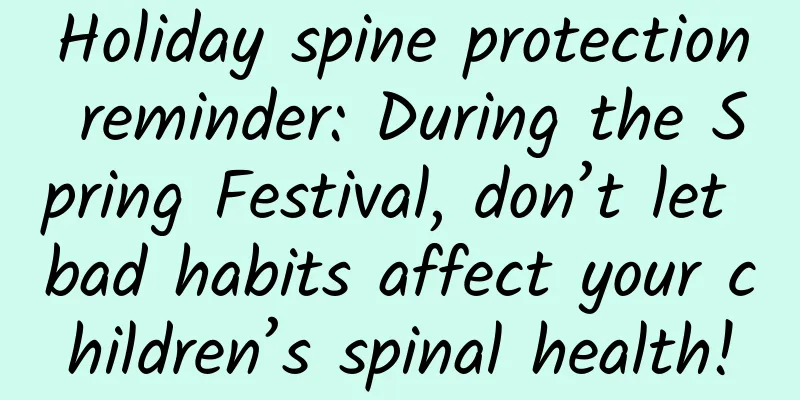Holiday spine protection reminder: During the Spring Festival, don’t let bad habits affect your children’s spinal health!

|
The Spring Festival is a wonderful time for family happiness and relaxation, but during this period, some bad habits formed inadvertently may quietly affect the spinal health of teenagers. During the Spring Festival, children's daily routines become irregular. They often stay on the sofa for a long time to play with their mobile phones and tablets for several hours, and their heads are bent at an angle far beyond the normal range. When visiting relatives and friends, they always sit on the sofa with their legs crossed to watch TV and eat snacks under the "indulgence" of their elders. When doing homework or reading, they no longer pay attention to their sitting posture as usual, and it is common to see them hunched over or lying on the table. These seemingly normal behaviors put a lot of pressure on the spine. Experts from the Xiangdong Hospital affiliated to Hunan Normal University said that adolescence is a critical stage of growth and development, but problems such as scoliosis and poor posture are becoming increasingly prominent, with an incidence rate of 3%-5% and an upward trend. These problems not only affect children's appearance, but also have long-term negative effects on health, such as back pain, affecting internal organ function, and causing mental health problems. During this Spring Festival, let us pay attention to the spinal health of young people and give them a special "New Year gift" for their healthy growth. 1. The harm of scoliosis and bad posture 1. Affect the appearance Scoliosis can cause uneven shoulders, tilted body, bulging back and other abnormal appearances, which seriously affect the appearance of teenagers. Imagine a teenager who should be upright but looks twisted because of scoliosis. This will undoubtedly deal a heavy blow to their self-confidence. According to a survey of 500 adolescents with scoliosis, about 60% of them feel inferior due to appearance problems. At this age when they love beauty, these problems will make them unable to hold their heads up in front of their peers and even affect their social activities. 2. Lower back pain Scoliosis can cause uneven force on both sides of the spine, which can easily cause back pain and affect patients' daily life and study. This pain is like an invisible shackle that restricts children's activities. In class, they cannot concentrate because of back pain; when exercising, they cannot sweat as much as they want because of pain. Statistics show that scoliosis patients are 2.5 times more likely to experience low back pain than normal people, which means they have to endure more pain and their quality of life is greatly reduced. 3. Affecting visceral functions Scoliosis may change the shape of the chest, causing pressure on the respiratory, circulatory, and digestive systems, leading to symptoms such as shortness of breath, chest tightness, and loss of appetite. Severe scoliosis can make children feel like there is a big stone pressing on their chest, causing difficulty breathing and chest tightness. Loss of appetite prevents them from enjoying delicious food, and their bodies do not get enough nutrition. A medical study found that adolescents with severe scoliosis may have their lung function reduced by about 30%. This not only affects their physical health, but also brings many inconveniences to their future lives. 4. Mental health issues Changes in appearance can cause psychological problems such as inferiority and anxiety in adolescents, affecting their social and mental health. Related studies have shown that adolescents with scoliosis are 40% more likely to suffer from depression than normal people. They may become introverted because of their appearance, unwilling to communicate with others, and suffer from huge psychological pressure. If such psychological problems are not solved in time, it will have a profound impact on their lives. 2. How to self-diagnose scoliosis Parents can help their children self-diagnose scoliosis by: 1. Standing position inspection Ask the child to take off his shirt, stand straight with his feet together and aligned, and let his arms hang naturally. Observe whether the child's head is centered, whether the shoulders are at the same height, whether the shoulder blades are at the same height, and whether the two sides of the pelvis are at the same height. When performing the standing position examination, make sure the child is on a stable surface and has sufficient light so that you can observe the child's posture more clearly. If the head is significantly deviated from the midline, one shoulder is higher than the other, the shoulder blades are one forward and one backward, or the two sides of the pelvis are not at the same height, then the child may be at risk of scoliosis. In addition, you can also let the child cross his arms in front of his chest and observe whether there is any asymmetry in the back. 2. Check while bending over Ask the child to stand with his feet shoulder-width apart and bend forward with his hands together. Observe the back from behind to see if there are any asymmetrical bulges. The bending position can more intuitively see the curvature of the spine. If one side of the back is significantly higher than the other side when bending over, it is likely a manifestation of scoliosis. At the same time, ask the child to slowly rotate the body to observe whether there are any abnormal changes in the back during the rotation. 3. Supine examination Observe whether the child's legs are the same length. Have the child lie flat on the ground with their legs straight and observe whether their legs are the same length. If there is a significant difference in leg length, this may also be a sign of scoliosis. Alternatively, have the child bend his knees and observe whether the height of the knees is the same. 4. Sports observation Observe whether the child's limbs exert force symmetrically and whether the muscle development is balanced during exercise. When the child is running, jumping, etc., pay attention to whether their limb movements are coordinated. If you find that one side of the limb is obviously insufficient in force or the muscle development is significantly different from the other side, you should also be alert to the possibility of scoliosis. For example, you can observe whether the child's body is tilted or the arm swing is asymmetrical when running. 3. How to check scoliosis in hospitals or professional institutions If you find that your child may have scoliosis through self-testing, it is recommended that you take your child to a hospital or professional institution for further examination. Doctors or professionals usually use the following methods to examine and evaluate scoliosis: 1. Physical examination Observe posture: The doctor will ask the child to take off his/her shirt and observe his/her posture when standing and bending over, including whether the shoulders are at the same height, the back is symmetrical, the legs are of the same length, etc. This is similar to the self-test method, but the doctor has more experience and expertise and can more accurately determine whether there is any abnormality. Touch the spine: The doctor will touch the child's spine with his hands to check the curvature of the spine, whether there are protrusions or depressions, etc. By touching, the doctor can initially understand the shape of the spine and the degree of scoliosis. 2. Imaging examination X-ray examination: X-ray examination is the gold standard for diagnosing scoliosis. The doctor will take X-rays of the child's spine, including front-back and lateral views in a standing position. Through X-rays, the doctor can clearly see the shape of the spine, measure the angle of the scoliosis, and assess the severity of the scoliosis. In addition, X-rays can also help doctors rule out other possible diseases, such as spina bifida, spinal tumors, etc. MRI or CT scans: In some cases, if the doctor suspects that scoliosis is caused by other diseases, such as spinal cord tumors, syringomyelia, etc., an MRI or CT scan may be recommended. These tests can observe the structure of the spinal cord and surrounding tissues of the spine in more detail, helping doctors make a more accurate diagnosis. 3. Other examinations Pulmonary function tests: Severe scoliosis may affect lung function, so your doctor may recommend a pulmonary function test to assess whether your child's breathing function is normal. Neuromuscular examination: If the doctor suspects that scoliosis is related to neuromuscular disease, a neuromuscular examination such as electromyography and nerve conduction velocity test will be performed. 4. Correction and Training Methods 1. Develop good posture habits Correction of study posture: When reading and writing, keep the book at a 30-degree angle to the table, place your feet flat on the ground, keep your knees and hips at right angles, and keep your back close to the back of the chair. A survey of 800 middle school students found that the incidence of scoliosis was reduced by 15% after posture correction. A good study posture can not only prevent scoliosis, but also improve learning efficiency. Parents should remind their children to pay attention to their sitting posture, check their study posture regularly, and correct bad habits in time. Standing and walking posture: Keep your head and chest up, shoulders relaxed, and avoid hunching or leaning forward. When walking, put your heels on the ground first and walk steadily. Standing and walking posture is an important aspect of a person's temperament. Good posture can make children look more confident and upright. Parents can help children develop good standing and walking habits through demonstration and reminders. Avoid bowing your head for long periods of time: Raise your head and move your neck every 30 minutes. You can use a mobile phone stand or computer stand to reduce the time you bow your head. According to research, bowing your head for long periods of time will increase the pressure on the cervical spine and increase the risk of scoliosis by 20%. In modern society, mobile phones and computers have become an indispensable part of children's lives. Parents should guide their children to use electronic products reasonably, avoid bowing their heads for long periods of time, and regularly exercise their necks to relieve pressure on the cervical spine. 2. Strengthen physical exercise Swimming: Swim at least three times a week, 30 minutes each time, with a focus on breaststroke and freestyle to train back muscles. A study showed that adolescents who swam three times a week for three consecutive months had a 70% improvement in scoliosis. Swimming is a full-body exercise, especially effective for training back muscles. Breaststroke and freestyle can effectively stretch the muscles on both sides of the spine and promote normal development of the spine. Hanging horizontal bar: Hanging horizontal bar training every day after school, 10 minutes each time, helps stretch the spine and relieve back muscle tension. Studies have shown that hanging horizontal bar training can improve spinal flexibility and reduce scoliosis. Hanging horizontal bar training is simple and easy, and does not require special venues and equipment. Parents can install a horizontal bar at home and let their children train every day after school, which can not only exercise the body but also enhance parent-child interaction. Pull-ups: Perform pull-ups three times a week, three sets of 10 each time, to exercise the back, shoulder and arm muscles and enhance spinal stability. Data show that pull-ups can improve back muscle strength and reduce the recurrence rate of scoliosis. Pull-ups are a high-intensity exercise that requires a certain amount of strength and endurance. Parents can guide their children to do pull-ups step by step according to their actual situation to avoid overexertion. 3. Pay attention to your living habits Choose the right mattress and pillow: The mattress should not be too soft or too hard, and the height of the pillow should be about one fist high. Avoid lying on your side or prone for a long time. According to sleep research, lying on your side and prone will increase the pressure on the spine and affect its normal development. A good sleeping environment is essential for spinal health. Parents should choose the right mattress and pillow for their children to ensure their sleep quality and promote the normal development of the spine. Avoid bad posture: Avoid crossing your legs for a long time, keep sitting upright, and get up and move around every hour. Crossing your legs increases the risk of pelvic tilt, which in turn causes scoliosis. Maintaining a bad posture for a long time is one of the important causes of scoliosis. 4. Rehabilitation training methods McKenzie bed training: adjust the angle of the bed according to the child's spinal condition, and perform it twice a day for 20 minutes each time. McKenzie bed training is a professional rehabilitation training method that needs to be adjusted according to the child's specific situation. Training under the guidance of a professional rehabilitation therapist can effectively improve scoliosis. Hip bridge training: Lie on your back with your knees bent, press your heels on the ground and lift your hips until your thighs and body are in a straight line, hold for 1 to 2 seconds, then lower your hips, and repeat 15 to 20 times. Hip bridge training can exercise the core muscles and enhance spinal stability. Prone Swallow Flying: Lie on your stomach, lift your arms and legs gently at the same time, hold for 1 to 2 seconds and then put them down, repeat 15 to 20 times. Prone Swallow Flying can exercise the back muscles and improve spinal flexibility. Parents can train with their children to increase parent-child interaction and exercise at the same time. Abdominal breathing: Lie on your back, expand your abdomen as much as possible when you inhale, and contract your abdomen as much as possible when you exhale, repeating this cycle 15 to 20 times. Abdominal breathing can help relax your abdominal muscles and relieve spinal pressure. Chest expansion exercise: Stand with your arms bent and placed in front of your chest, then swing them to both sides, inhale when expanding your chest, exhale when closing your chest, and repeat 15 to 20 times. Chest expansion exercise can exercise chest muscles and improve your posture. Four-point kneeling training: Kneeling at four points, perform the body center of gravity swinging back and forth training, 20 times each time. Four-point kneeling training can exercise the core muscles and enhance spinal stability. Diagonal exercise: Kneel at four points, lift one upper limb and the opposite lower limb at the same time, hold for 1 to 2 seconds and then put them down, alternate left and right, and repeat 15 to 20 times. Diagonal exercise can exercise the core muscles and enhance spinal stability.
(Edited by Wx) |
>>: [Science Popularization Officer of the Tenth Hospital] Mitral valve prolapse is a health alarm
Recommend
How to deal with vaginal swelling in six months of pregnancy
If swelling of the vagina occurs during the sixth...
Women have it, men may have it, and pregnant mothers definitely have it! What exactly is this line?
Audit expert: Wang Linyu Deputy Chief Physician, ...
Normal range of ovarian size by ultrasound
Today's technology is very advanced, especial...
Do sit-ups harm your uterus?
There are many people who like to exercise in lif...
How to improve kidney and spleen deficiency in women
Kidney deficiency and spleen deficiency are commo...
Is a 7 cm uterine fibroid serious?
The growth of uterine fibroids is a very troubles...
What is the best way to treat vaginal candidiasis?
Almost 50% of women have suffered from vaginitis,...
Causes of gynecological inflammation
Gynecological inflammation has caused a lot of ha...
How to distinguish male and female crabs? How to catch crabs
Most crabs are omnivores, usually feeding on aqua...
What exactly is the reason for being “grumpy when waking up”?
There is a kind of "anger" called "...
What is the cause of abdominal distension and pain and increased leucorrhea?
A large number of female friends have reported th...
How to prevent mice from entering the engine compartment? Why do mice enter the engine?
We often see news about car owners getting small ...
"Why is my blood pressure getting less and less accurate?" 4 issues to pay attention to when measuring your blood pressure yourself
A friend with high blood pressure told Huazi that...
Left inverted nipple?
Inverted nipple is a very common phenomenon in li...
Pregnant woman acid reflux water is a boy or a girl
The most important feature of a woman giving birt...









